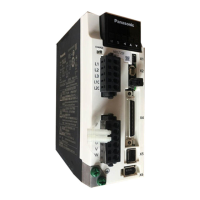
Do you have a question about the Panasonic MINAS A6 Multi Series and is the answer not in the manual?
| Brand | Panasonic |
|---|---|
| Model | MINAS A6 Multi Series |
| Category | Servo Drives |
| Language | English |
Overview of MINAS A6 Multi series, driver, and power supply modules.
Details on control methods, encoder feedback, scale feedback, and communication interfaces.
Specifies functions for position control, including input, output, and command modes.
Details functions for velocity control, including command input and output signals.
Describes functions for torque control, including command input and output signals.
Explains functions for full-closed control using external scale feedback.
Details common functions like electronic gear ratio, auto-tuning, and protective functions.
Compares specifications between MINAS A6BF and MINAS A6 Multi series.
Details of input signals for I/O connector, including symbols, pin numbers, and functions.
Details of output signals for I/O connector, including symbols, pin numbers, and functions.
Describes position comparison output signals and other miscellaneous I/O signals.
Explains how to allocate input and output signals to I/O connector pins.
Provides parameters for changing input signal assignments to I/O pins.
Details on assigning output functions to output pins of the I/O connector.
Details parameters for reallocating output signals to output pins.
Describes the mechanical brake release signal output and relevant parameters.
Illustrates the front panel layout with components like LEDs, switches, and connectors.
Procedure for setting inter-module communication node addresses using DIP switches.
Describes methods and parameters for setting EtherCAT Station alias.
Explains the status indicated by RUN and ERR LEDs on the EtherCAT interface.
Details the information displayed on the 7-segment LED in different modes.
Explains how the station alias is displayed upon initial power-up.
Describes common status and parameters for displaying driver information on the LED.
Explains how to switch to and display safety information on the driver module.
Sets the polarity for position, velocity, and torque commands, and offsets.
Explains how the driver module performs position control via EtherCAT commands.
Allows setting electronic gear ratio for desired motor revolutions per command.
Applies command filters (smoothing, FIR) to smooth the positional command.
Verifies positioning completion using INP or INP2 output signals.
Details how the driver module performs speed control via EtherCAT speed commands.
Outputs AT-SPEED signal when motor reaches the set speed.
Outputs V-COIN signal when motor speed matches the velocity command.
Explains torque control based on EtherCAT torque commands and speed limits.
A protective function regulating motor speed to not exceed the set speed limit.
Controls position using direct feedback from an external scale.
Describes the selection of external scale type and direction for full-closed control.
Sets the division ratio using encoder and external scale resolutions.
Sets deviation allowance between motor and load positions for error detection.
Enables absolute system configuration without homing at power-on.
Details absolute system configuration using EtherCAT and battery installation.
Explains absolute system configuration using an external scale.
Overview of automatic adjusting functions including real-time auto tuning and adaptive filter.
Estimates load characteristics and performs gain setting and friction compensation.
Estimates resonance frequency and removes it from torque command to reduce vibration.
Performs auto tuning for standard 2-DOF control by estimating load characteristics.
Auto tuning function for synchronization type 2-DOF control, estimating load characteristics.
Explains manual gain tuning methods for optimizing response and stability.
Illustrates the block diagram for position control modes (pp, csp, hm).
Illustrates the block diagram for velocity control modes (pv, csv).
Illustrates the block diagram for torque control modes (tq, cst).
Illustrates the block diagram for full-closed control modes.
Allows selecting appropriate gain based on internal data or external signals.
Suppresses resonance peaks to reduce vibration or lower gain.
Reduces vibration by removing frequency components from the positional command.
Improves response and reduces deviation by adding velocity/torque feed forward.
Reduces disturbance torque and vibration using a disturbance observer.
Increases gain before stopping to shorten positioning time.
Compensates for offset torque, dynamic friction, and viscous friction.
Suppresses vibration from motor-load twist in full-closed control.
Suppresses high-frequency vibration using a 2-stage torque filter.
Suppresses quadrant projection during multi-axis arc interpolation.
Allows independent setting of command response and servo stiffness in position control.
Allows independent setting of command response and servo rigidity in velocity control.
Allows independent setting of command response and servo rigidity in full-closed control.
Improves current control responsiveness by increasing current response setup value.
Changes torque limit value based on the direction of operation.
Sets motor movable range; triggers software limit protection if exceeded.
Defines motor deceleration and stop sequence upon alarm or main power OFF.
Sets the operation sequence for the servo-off state.
Sets the operation sequence when the main power supply is OFF.
Sets the operation sequence when an alarm occurs.
System controls and immediately stops motor on alarm requiring emergency stop.
Prevents robot arm fall by maintaining motor energization until external brake operates.
Smoothly stops motor via control when servo is ON upon drive prohibition input.
Activates alarm if torque saturation continues for a fixed period.
Outputs pulse signal when actual position passes a set position.
Uses absolute encoder for single-turn data without battery power.
Sets any upper limit for absolute encoder multi-turn data for continuous turn.
Checks motor/equipment changes to output deterioration diagnosis warning.
Lists protective functions, error numbers, causes, and troubleshooting measures.
Provides detailed causes and measures for various protective functions and error codes.
Presents overload preventive time characteristics graphs for different motor types.
Explains warning triggers, latch states, and types of warnings.
Lists general warning types like overload, PSM regeneration, and encoder errors.
Lists extended warning types, including PSM main power off and PANATERM execution.
Sets parameters for safe operation before gain adjustment.
Details protection settings for homing return using the Z phase.
Overview of 14 safety functions and their corresponding safety levels (SIL, PLe, Cat4).
Shows encoder configurations required for various safety functions.
Details safety input/output signals, including duplex inputs and brake outputs.
Provides connection examples for safety output and brake output circuits.
Outlines the operation of STO, SSX, SS2, SLS, SSM, SBC, SLP, SCA safety functions.
Describes optional functions like SEL, SRX, SRS, EDM, ECS, and ICS.
Explains changes from MINAS-A5 and the outline of the STO function.
Illustrates the timing diagram for activating the STO state.
Illustrates the timing diagram for returning from the STO state.
Guides on using PANATERM for Safety software to program safety functions.
Explains how safety monitoring programs affect driver module motor control.
Provides the procedure for clearing resettable safety alarms.
Lists critical safety precautions for using safety functions and equipment.
Provides a comprehensive list of all parameters, their attributes, and related information.
Details parameters for basic settings like control mode and auto-tuning setup.
Lists parameters related to gain adjustment for position, velocity, and torque control.
Details parameters for adaptive filters and notch filters used in damping control.
Lists parameters for velocity, torque, and full-closed control functions.
Details parameters for configuring I/O signal allocation and monitoring.
Lists parameters for enhancing functions like over-travel inhibit and sequence setups.
Details parameters for special settings like speed deviation, gain switching, and function expansion.
Lists parameters for LED display, correction times, and communication function setup.
Parameters designated as 'For manufacturer's use'.
Parameters designated as 'For manufacturer's use', not EtherCAT accessible.
Parameters designated as 'For manufacturer's use', not EtherCAT accessible.
Illustrates the timing for servo drive system startup from control power application.
Shows timing for servo ON/OFF when the motor is stopped (servo-lock).
Shows timing for servo ON/OFF when the motor is rotating.
Illustrates timing when an alarm occurs and the module stops via dynamic brake or free-run.
Illustrates timing when an alarm occurs and the module stops via emergency stop.
Shows timing for driver module operation after an alarm clear command is executed.
Provides basic specifications for the power supply module (PSM).
Details the connectors for inter-module communication and external device signals.
Describes the output terminal for controlling the magnetic contactor via EtherCAT.
Details inputs for monitoring magnetic contactor and regenerative resistor.
Explains the status indicated by the RDY and ERR LEDs on the front panel.
Presents the basic block diagram and functions of the power supply module.
Describes parameters related to the regenerative control function of the power supply module.
Details parameters related to main power off detection.
Lists PSM protection functions, alarms, and their attributes for troubleshooting.
Provides detailed causes and measures for PSM alarms.
Lists PSM warning factors and their causes.
Lists all parameters for the power supply module (PSM).
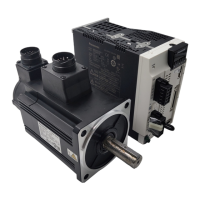

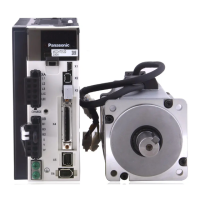
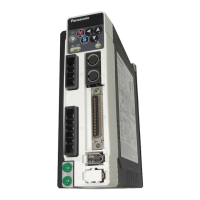

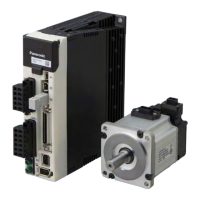
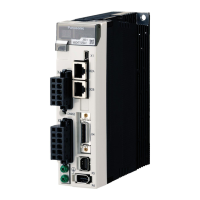





